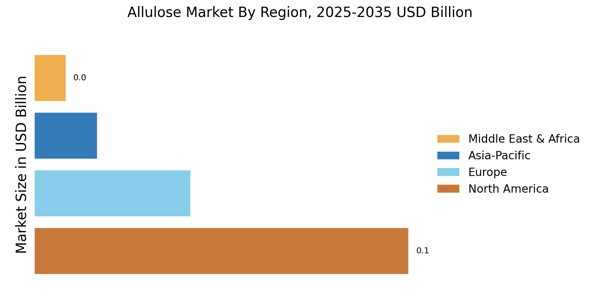Innovation in Food Technology
The Allulose Market is poised for growth due to ongoing innovation in food technology. Advances in food processing and formulation techniques are enabling manufacturers to create products that effectively incorporate allulose while maintaining desirable taste and texture. This innovation is crucial, as it addresses the challenges associated with using low-calorie sweeteners, such as aftertaste and solubility. Recent developments in food technology suggest that allulose can be utilized in a wider array of applications, from frozen desserts to sauces, without compromising quality. As food technologists continue to explore the potential of allulose, the market is likely to see an influx of new products that cater to diverse consumer preferences. This emphasis on innovation not only enhances the appeal of allulose but also positions it as a key player in the evolving landscape of the food and beverage industry.
Growing Interest in Natural Sweeteners
The Allulose Market is experiencing a growing interest in natural sweeteners, as consumers increasingly seek products derived from natural sources. Allulose Market, being a naturally occurring sugar found in certain fruits, aligns well with this trend. The shift towards natural ingredients is evident in consumer purchasing behavior, with many preferring products that are perceived as healthier and more wholesome. Market Research Future indicates that the natural sweetener segment is anticipated to grow at a rate of approximately 7% over the next few years. This trend suggests that allulose, with its natural origins and low-caloric profile, is likely to gain traction among health-conscious consumers. As the demand for clean label products continues to rise, the Allulose Market stands to benefit from the increasing preference for natural sweetening agents.
Rising Demand for Low-Calorie Sweeteners
The Allulose Market is experiencing a notable surge in demand for low-calorie sweeteners, driven by an increasing awareness of health and wellness among consumers. As individuals seek to reduce sugar intake while maintaining sweetness in their diets, allulose emerges as a favorable alternative. Recent data indicates that the low-calorie sweetener market is projected to grow at a compound annual growth rate of approximately 5.5% over the next five years. This trend suggests that allulose, with its unique properties and minimal caloric content, is well-positioned to capture a significant share of this expanding market. Furthermore, the rising prevalence of obesity and diabetes has prompted consumers to seek healthier options, thereby bolstering the demand for allulose in various food and beverage applications.
Regulatory Support for Low-Calorie Sweeteners
The Allulose Market benefits from favorable regulatory support that encourages the use of low-calorie sweeteners. Regulatory bodies in various regions have recognized the potential health benefits of allulose, leading to its approval for use in food products. This regulatory backing not only enhances consumer confidence but also incentivizes manufacturers to incorporate allulose into their offerings. For instance, the approval of allulose by the Food and Drug Administration (FDA) as a Generally Recognized as Safe (GRAS) substance has paved the way for its widespread adoption. As regulations continue to evolve, the Allulose Market is likely to see an influx of innovative products featuring allulose, further driving market growth. The supportive regulatory environment may also lead to increased research and development efforts focused on optimizing allulose's applications in various food categories.
Increased Adoption in Food and Beverage Products
The Allulose Market is witnessing increased adoption of allulose in a diverse range of food and beverage products. Manufacturers are incorporating allulose into their formulations to cater to the growing consumer preference for healthier alternatives. This trend is particularly evident in the beverage sector, where allulose is being utilized in low-calorie drinks, energy drinks, and flavored waters. According to market analysis, the beverage segment is expected to account for a substantial portion of the allulose market, with a projected growth rate of around 6% annually. Additionally, the versatility of allulose allows it to be used in baked goods, dairy products, and confectionery, further enhancing its appeal to food manufacturers. As consumers increasingly prioritize taste without compromising health, the integration of allulose into various products is likely to continue to rise.


















Leave a Comment